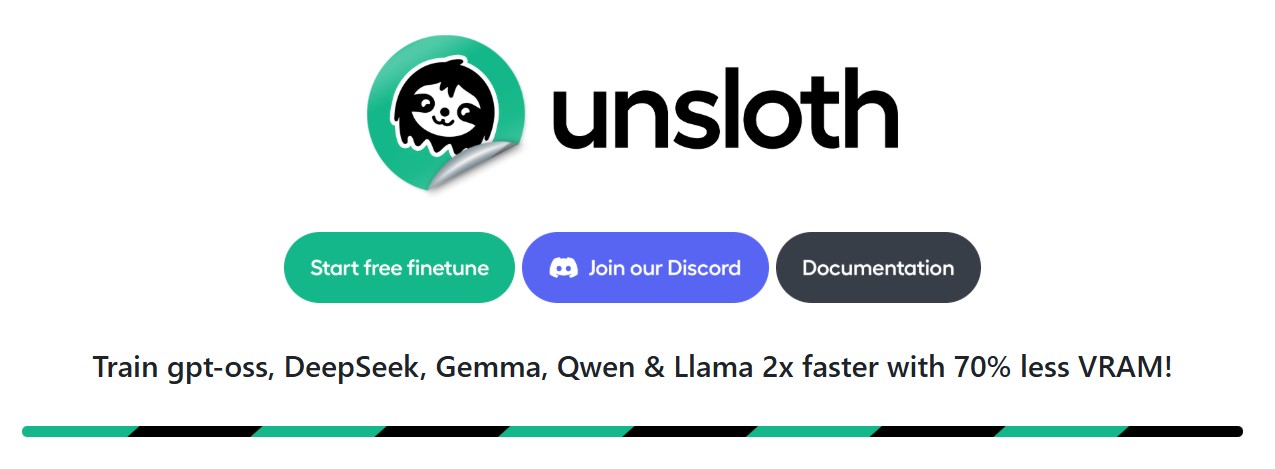As large language models (LLMs) continue to evolve, fine-tuning them efficiently has become one of the biggest challenges in the AI community. From OpenAI’s gpt-oss to Gemma 3, Llama 3, and Qwen3, the models are growing larger and more capable but also more resource-hungry. Most developers and researchers struggle with the massive GPU memory requirements, long training times and complicated setup processes.

This is where Unsloth AI steps in. Developed by the open-source community at UnslothAI, this framework is designed to make LLM training twice as fast while consuming up to 70% less VRAM. Compatible with a wide range of models including GPT, Llama, Mistral, Qwen and DeepSeek, Unsloth allows anyone with a modest GPU setup to fine-tune large models seamlessly.
Whether you’re into reinforcement learning (RL), text-to-speech (TTS) or vision-language models (VLMs), it provides an optimized, flexible and cost-effective ecosystem that redefines what’s possible in AI training.
Why Unsloth Is Transforming LLM Training ?
It isn’t just another Python library – it’s a performance-focused AI acceleration framework built for developers, researchers and enthusiasts who want to push boundaries without spending a fortune on hardware. Here’s what makes it stand out:
1. Blazing Fast Fine-Tuning
It speeds up model training by 1.5× to 2.2×, depending on the model and setup. It achieves this through custom GPU kernels written in OpenAI’s Triton language, optimized attention mechanisms and a re-engineered backpropagation engine.
Models like Llama 3.1 (8B) and Mistral v0.3 (7B) train twice as fast while using nearly half the memory compared to Hugging Face’s default methods.
2. Massive VRAM Savings
With up to 80% less VRAM usage, it is ideal for developers using mid-range GPUs such as RTX 3060 or 4070. For instance, a 20B parameter model can now be fine-tuned on a 14GB GPU while a 120B model fits into 65GB VRAM something previously unthinkable without expensive infrastructure.
3. Full Model Compatibility
It supports all major architectures, including:
- GPT-OSS, DeepSeek-R1, Gemma 3, Qwen3, Phi-4, Mistral and Llama 3.3
- Multimodal & TTS models like Qwen2.5-VL and Orpheus-TTS
- Reinforcement Learning (RL) methods like GRPO, GSPO, DrGRPO and DAPO
If it works with Hugging Face Transformers, it works with Unsloth.
4. No Accuracy Loss
Despite its aggressive optimization, it ensures 0% loss in model accuracy. It doesn’t use approximation methods; all training computations are exact providing performance gains without compromising output quality.
5. Cross-Platform Support
Unsloth runs seamlessly on:
- Linux and WSL
- Windows (with CUDA & PyTorch)
- Docker containers
- DGX Spark & NVIDIA Blackwell systems
It supports NVIDIA, AMD, and Intel GPUs with CUDA capability 7.0 or higher including V100, T4, A100, H100 and the new RTX 50 series.
Simple Installation & Quickstart Guide
Getting started with Unsloth is refreshingly straightforward. You can install it directly via pip:
pip install unsloth
If you’re on Windows, make sure PyTorch is installed before running the command. For Docker users, Unsloth provides a ready-to-use container that includes all dependencies:
docker run -d -e JUPYTER_PASSWORD="mypassword" \ -p 8888:8888 -v $(pwd)/work:/workspace/work --gpus all unsloth/unsloth
Once the container starts, you can access JupyterLab at http://localhost:8888 and begin training instantly.
For advanced users, Unsloth also supports Conda environments and custom CUDA/Torch version combinations – all documented in their official installation guide.
Performance That Redefines Efficiency
Unsloth’s performance benchmarks have impressed both researchers and practitioners. In comparative tests using the Alpaca dataset, models trained with Unsloth achieved 2× faster speed and 75% lower VRAM consumption than Hugging Face + FA2 setups.
Example: Llama 3.1 (8B)
| GPU VRAM | Unsloth Context Length | Hugging Face Context Length |
|---|---|---|
| 12 GB | 21,848 | 932 |
| 24 GB | 78,475 | 5,789 |
| 40 GB | 153,977 | 12,264 |
Unsloth allows context lengths exceeding 340,000 tokens, a huge advantage for tasks like long-document summarization and dialogue-based reinforcement learning.
Example: Mistral v0.3 (7B)
- Speed: 2.2× faster training
- VRAM savings: 75%
- Batch size: Up to 2× larger
These benchmarks demonstrate that Unsloth isn’t just efficient, it’s scalable and future-ready.
Advanced Capabilities
Beyond traditional fine-tuning, Unsloth also offers:
- Reinforcement Learning (RL): Full support for GRPO, GSPO, ORPO, DPO, and PPO training loops.
- Text-to-Speech (TTS): Works with models like sesame/csm-1b and whisper-large-v3.
- Dynamic Quantization 2.0: Enables state-of-the-art performance on 5-shot MMLU benchmarks.
- Multi-GPU support (coming soon): To further expand scaling possibilities.
It also provides integration options for exporting models to GGUF, Ollama, vLLM or Hugging Face Hub for instant deployment.
Community, Documentation and Open Source Spirit
The Unsloth project is maintained by a vibrant open-source community led by Daniel Han, Michael Han and over 100+ contributors. It’s available under the Apache-2.0 license, ensuring transparency and open collaboration.
With a thriving GitHub base of 46,000+ stars and 3,800 forks, Unsloth’s popularity continues to rise among AI researchers and practitioners worldwide. The community is active on Reddit, X (Twitter) and Hugging Face Spaces, constantly sharing updates, guides and performance benchmarks.
Conclusion
In a world where compute costs and energy consumption dominate the AI conversation, Unsloth AI represents a bold step toward accessible, sustainable and high-performance model fine-tuning.
By offering 2× faster training, up to 80% less VRAM usage and full compatibility across the latest models and GPUs, Unsloth has set a new benchmark in the field of efficient AI training.
Whether you’re a researcher exploring RL algorithms, a startup deploying multimodal AI systems or a developer experimenting with open-weight models, it empowers you to do more, faster and smarter.
Follow us for cutting-edge updates in AI & explore the world of LLMs, deep learning, NLP and AI agents with us.
Related Reads
- Ultimate OpenTSLM: Stanford’s Open-Source Framework Bridging LLMs and Medical Time-Series Data
- Quivr AI: Building Your Second Brain with Open-Source Generative Intelligence
- Top 20 Ultimate Bollywood Diwali Portrait Ideas for Women Using Gemini AI
- Try Powerful Mem0 AI to build Long-Term Memory for AI Agents
- Grok AI Chatbot (2025): Elon Musk’s Bold Answer to Real-Time, Intelligent Conversation


4 thoughts on “Unsloth AI: The Game-Changer for Efficient 2*Faster LLM Fine-Tuning and Reinforcement Learning”